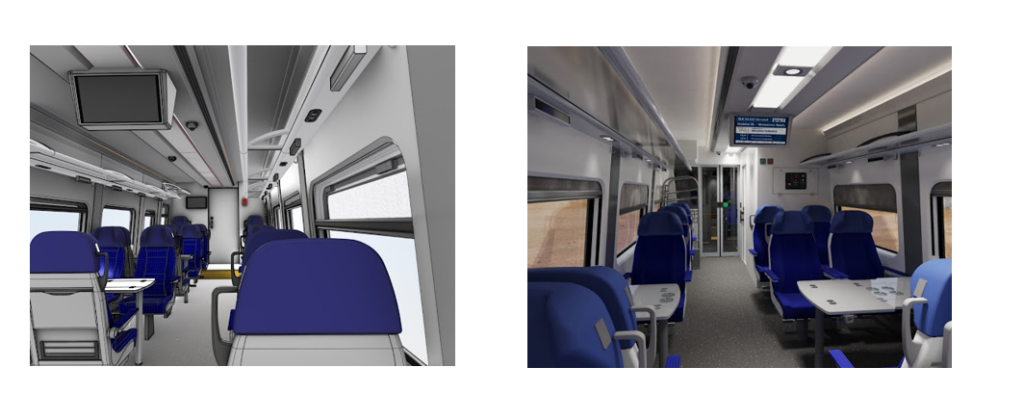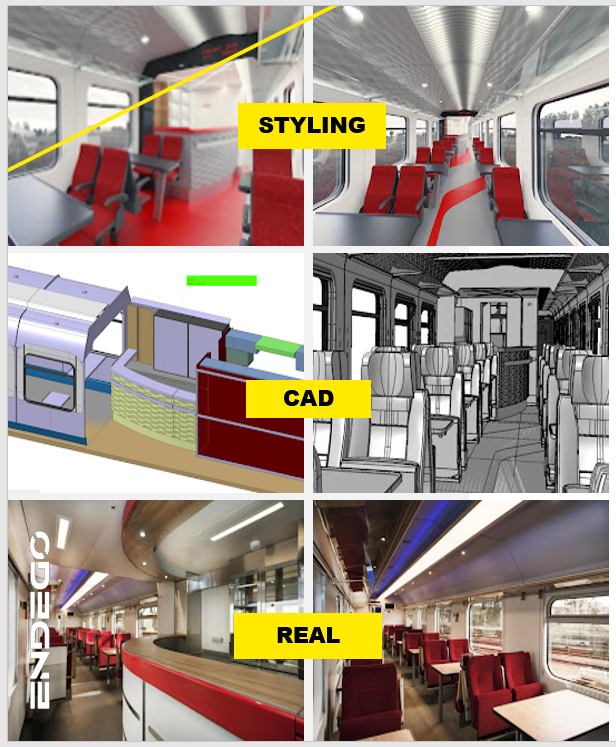Thanks to its extensive experience in the design of rail vehicles, its collaboration with innovative manufacturers in the rail industry, and its extensive know-how and extensive technological facilities, Endego is already in a position to create the rail vehicles of the future.
From the extensive modernisation of PESA units, railway bogies for Polski Tabór Szynowny, and various types of carriages to the complex creation of tramway designs, Endego has a wealth of experience working on modern rail vehicles. With know-how, professional staff, and state-of-the-art design and simulation software, the company is already ready for the challenges of the future of railways.
Modernisation of PESA ED74 units: our company became famous in the industry thanks to our success in modernising ED74 units. More than 10 years after their production, when it became clear that they did not meet functional expectations, we redesigned their interiors and equipment. Responsibility for lighting, seat installation, and other elements was part of our involvement in the project.

Modernisation of PESA ED72 units: For ED72 units, our company also undertook a comprehensive modernisation. Here are the key aspects of this project:
This resulted in a significant improvement in the standards and quality of ED72 vehicles.
Platforms for container wagons: one of the challenges we took on was to design platforms for container wagons to transport wooden logs. We created special connections and steel structures that enable containers and timber to be stably erected. Our designs have helped to transport timber logs efficiently, significantly improving the logging process.

H-type Railway Trolley: We developed an H-type railway trolley for Polski Tabór Szynowski of Ostrow Wielkopolski. This design was unique due to its open construction, lack of a beam at the front, and compliance with stringent railway standards, including the EN15085 welding standard.
Conversion of wagons 152 and 154: Our company is involved in the design of the toilet cabins, including installations and fittings during the conversion of wagons 152 and 154. The dynamic calculations of the tanks, aesthetics, and careful selection of materials are key aspects of this project.
Other Projects: Endego has also made significant contributions to the design of trams, and restaurant cars. Our services include calculations to reduce the weight of the vehicles and improve their thermal properties.

Our team’s expertise in rail vehicles covers the full range of component design and analysis services. Our calculation and design skills are renowned in the rail industry for meeting the highest standards of performance, safety, and aesthetics. We are ready to take on further challenges and provide innovative solutions. Our main focus in our work is:
A priority when designing rail vehicles is to ensure both passenger safety and passenger comfort. Our solutions meet the highest standards for safety, quality, and durability, which improve the passenger journey.
Endego understands that different customers have different needs and requirements. That is why the company offers customised solutions to create personalised transport solutions.
Railways, being a dynamic field of transport, are constantly adapting to new trends and innovations. Among the predicted trends for the future are:
One promising trend in the rail industry is the development of hydrogen-powered vehicles. We are already seeing the beginnings of this trend in Poland, where the first prototypes of hydrogen-powered locomotives have appeared in the last two years. Hydrogen vehicles can contribute to a significant reduction in greenhouse gas emissions and more sustainable rail transport.
Another key trend is the switch of the entire railway industry to TSI (Technical Specifications for Interoperability) standards, which are international standards for the railway sector. This standardisation aims to improve interoperability and cooperation between the different railway systems in Europe. The move towards full compliance with TSI standards has the potential to facilitate the movement of goods and passengers within the European Union and to accelerate the development of the railways.
With technological developments and creative approaches to design, railway vehicles are gaining more and more modern and elegant silhouettes. Customers and passengers expect not only functionality but also an attractive appearance from railway vehicles. Examples of such designs include trains with innovative and futuristic designs that stand out from traditional solutions.
With broad and varied experience in design for rail, Endego’s experts are ready to co-create rail vehicles that follow the latest trends and respond to today’s and tomorrow’s challenges.
Contact us for more details and to work together to develop solutions tailored to your needs.
In the automotive industry, aerodynamics plays an increasingly important role in designing modern vehicles. For mass-produced cars, key commercial goals include high load capacity, speed and driving comfort, while simultaneously reducing fuel consumption and emissions. Therefore, understanding and effectively applying aerodynamics is a fundamental aspect of the design process. This is especially true with the growing number of electric and autonomous vehicles. Let’s find out which basic terms are worth knowing, why aerodynamics is so important for cars and how computer simulations help engineers optimise the airflow around vehicles.
Read moreReducing noise and vibration is one of the key issues in modern vehicle design. With NVH (Noise, Vibration, Harshness) analyses, engineers create cars that are more comfortable, safer and meet rigorous standards. How do engineering simulations support the vehicle design process in eliminating unwanted vibration and sound?
Read moreComputer simulations are changing the standards in vehicle design. They allow engineers to depict physical phenomena and so to minimise the need for costly prototypes. What opportunities do these technologies offer, and how do they impact efficiency, safety, and innovation in the automotive sector?
Read more